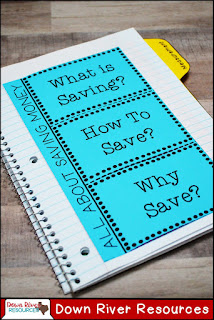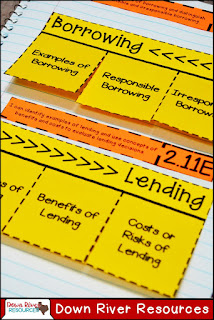Personal Financial Literacy is a significant, but under-taught set of skills in most elementary math curricula. Texas is leading the way in teaching its young children, as early as kindergarten, to how manage financial resources effectively, in order to have lifetime financial security. That is a big charge for the little people taught in Texas schools! As adults, we can understand why these skills are so important as they impact a person's entire life. Personal Financial Literacy will help our students develop into productive and responsible citizens in our community, state, and country.
Teaching Personal Financial Literacy

President George W. Bush, who is also a Texan, established an advisory council in 2008, when he was in the White House. His Executive Order, created this council to "improve financial literacy among all Americans." After one year this council recommended that schoolchildren should be exposed to the topic of Personal Financial Literacy as early as kindergarten and continue their learning throughout their school years.
This recommendation is the reason that Texas is leading the way to teaching young children the importance of managing one's finances to provide lifelong security.
Literacy skills are the building blocks of development which teach self-sufficiency, this included financial literacy. This is significant as it impact a child's future development and the society as a whole.
Why is Personal Financial Literacy Important?
Young Children are Using Their Money to Shop
Young children are exposed to advertising targeting them as their ideal customers. Shockingly, Parents Magazine reported in 2004 that “children ages 4 to 12 shell out an estimated $35.6 billion of their own cash annually, more than four times what they did a decade ago.”philanthropic thinking.
 High School Students Struggle With Basic Financial Skills
High School Students Struggle With Basic Financial Skills
Charles Schwab’s 2007 Teens & Money Survey found that teenagers are very optimistic about their chances for financial success and describe themselves to be financially savvy; however, the survey results showed a much different result when their supposed skill set was put to the test. Here were the results:- 51 percent knew how to write a check
- 34 percent could balance a checkbook
- 26 percent knew how credit card fees work
- 24 percent knew whether a check-cashing service is a good thing or bad thing to use

President Bush's Idea Behind Personal Financial Literacy
We want people to own assets; we want people to be able to manage their assets. We want people to understand basic financial concepts, and how credit cards work and how credit scores affect you, how you can benefit from a savings account or a bank account. That’s what we want. And this group of citizens has taken the lead, and I really thank them…
What are the Benefits of Teaching Personal Financial Literacy?
Personal Financial Literacy Supports Long-Term Learning
Some argue that money management is a skill taught in the home, the reality is that many parents are not willing or able to teach their children everything they need to know about finance; thus, students need to be exposed to money management at school. Texas' approach to Personal Financial Literacy is sometimes called a "spiral." (A topic is revisited repeatedly in different ways, increasing in depth, using different examples and contexts. Personal Financial Literacy is taught across multiple grade levels. Each grade level has a precise skill set that is to be mastered within each grade level. This allows students the opportunity to learn, relearn, and think deeper about money management.
Texas' approach to Personal Financial Literacy is sometimes called a "spiral." (A topic is revisited repeatedly in different ways, increasing in depth, using different examples and contexts. Personal Financial Literacy is taught across multiple grade levels. Each grade level has a precise skill set that is to be mastered within each grade level. This allows students the opportunity to learn, relearn, and think deeper about money management.The Personal Financial Literacy strand of the Texas standards is carefully articulated in each grade so that the skills and concepts
develop coherently at each successive grade level. It is the goal that this learning "snowballs" over time. Through repeated exposures over time, concepts and skills become embedded in the child’s long-term memory.
The President's Council also supported the benefit. They felt that:
financial education is a life-long endeavor, and that terminology, skills and behaviors must be learned repeatedly, starting at a very young age.
 Personal Financial Literacy Improves the Workplace
Personal Financial Literacy Improves the Workplace
Students need the skills, knowledge, and assistance to meet their future financial
challenges. When employees are worried about debt
and other personal finance issues, they have more difficulty focusing on their jobs and are not as productive.Stress, including personal economic stress, is estimated to cost business as much as $300 billion a year in lost productivity, increased absenteeism, employee turnover, and increased medical, legal and insurance costs, according to the American Institute of Stress.
Take a minute to think about how much of an impact you will have on your students' future by teaching this important subject!
Personal Financial Literacy Leads to Financial Security
According to the FDIC’s Alliance for Economic Inclusion, there are an estimated 28 million Americans that are “unbanked,” and 44.7 million more are “underbanked." So, 28 million Americans do not have their money secured in a bank and are, therefore, not earning interest on any of their money. They are not reaping the benefits of saving their money towards future wants and needs.
Without a bank account, it is also virtually impossible to get credit, receive Federal payments, or own property! Students need to know this so they can use a credit card responsibly, receive payments, and have the opportunity to own a home someday.
Many people who are underbanked feel:
- distrust in the banking system
- like they are unable maintain sufficient cash balances to avoid high monthly fees
- that if they write too few checks per month to need a checking account
- worried that they have too little monthly income to justify a savings account
These are the type of misconceptions that teachers can clear up if Personal Financial Literacy is taught in the math classroom.
You can read the President’s Advisory Council on Financial Literacy 2008 Annual Report to the President too! (All facts presented were found within this report.)
I hope this post inspires you to teach Personal Financial Literacy in your math classroom and if you want to use my notebook or other resources, they're in my TpT shop.
What other benefits do you think teaching Personal Financial Literacy has on students?








No comments